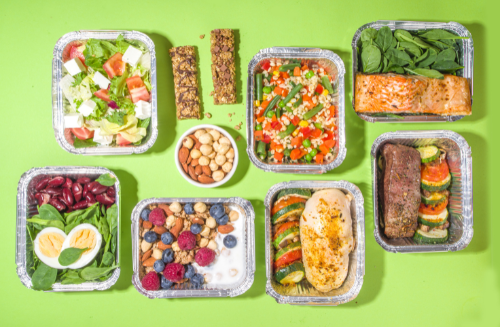Are you looking for the right healthy packaged food of autistic children? Finding the right balance between nutrition and sensory-friendly foods can be challenging, but it's essential for their well-being. We offer a range of products that fit into a clean eating meal plan, designed with soft textures, appealing flavors, and the highest nutritional standards in mind. Explore our selection of minimally processed, nutrient-rich foods that are perfect for kiddies lunch bags or quick snacks, ensuring your child enjoys meals that are both healthy and enjoyable.

1. Understanding the Unique Dietary Needs of Autistic Kids
When it comes to finding the right healthy packaged food for autistic kids, parents often face unique challenges. Autism Spectrum Disorder (ASD) can impact sensory processing, making it difficult for children to accept certain textures, flavors, or even colors of food. Additionally, many autistic children have specific dietary needs or preferences that require careful attention to ensure they receive the necessary nutrition. A healthy eating meal plan that includes clean eats and foods to eat that are both nutritious and sensory-friendly is essential.
2. Crafting a Clean Eating Meal Plan for Autistic Children
Creating a clean eating meal plan for an autistic child involves selecting foods that are not only healthy but also enjoyable for them to eat. Foods that are easy to prepare, such as those on a kiddies menu, can help make mealtime less stressful. It’s important to consider healthy eating habits, incorporating soft foods to eat or simple clean eats that can be easily packaged in kiddies lunch bags for school or outings.
3. Focus on Nutrient-Rich, Minimally Processed Foods
For those following a healthy eating meal plan, the focus should be on foods to eat that are minimally processed, free of artificial additives, and rich in nutrients. Clean simple eats, such as fresh fruits, vegetables, lean proteins, and whole grains, can be tailored to meet the specific needs of an autistic child. Including foods to eat like fiber-rich fruits and vegetables can aid in digestion and overall well-being. For parents asking « what should I eat » or « what should I feed my child, » having a variety of options is key.
4. Emphasizing Mindful Eating Practices
Mindful eating is also an important concept to consider. Teaching children to pay attention to the taste, texture, and feel of their food can help them develop healthy eating habits over time. This can be particularly beneficial for autistic children who may have a limited range of foods they are comfortable with. Introducing healthy snacks to eat, such as nuts, seeds, or simple clean eats like yogurt and fruit, can help broaden their palate.
5. Recognizing and Addressing Eating Challenges
It’s also important to be aware of the signs of not eating enough, which can be a concern for some autistic children. They may eat less due to sensory sensitivities or a lack of interest in food. A clean eating meal plan can help ensure they are getting enough of the right foods to eat, even if they are not eating large quantities. In these cases, nutrient-dense foods that pack a lot of vitamins and minerals into small portions can be very beneficial.
6. Practical Healthy Snack and Meal Options
For those wondering how to eat healthy and what are good healthy snacks for autistic children, options like clean simple eats greens, whole-grain crackers, and lean proteins can be incorporated into their diet. Clean eating food lists can guide parents in choosing healthy packaged food that meets their child’s dietary needs while also being convenient for busy days.
7. Balancing Nutrition and Sensory Needs
In conclusion, developing a healthy eating meal plan for an autistic child involves a careful balance of clean eats, mindful eating practices, and a focus on nutritious foods that cater to their specific sensory and dietary needs. By prioritizing healthy snacks to eat and incorporating a variety of foods to eat into their diet, parents can help ensure their child receives the essential nutrients needed for their growth and development.
Preparing meals for autistic children often involves considering sensory sensitivities, preferences, and nutritional needs. Here are some simple, healthy, and autism-friendly meal ideas that can be prepared at home:
1. Smoothie Bowls

– Why it’s good: Smoothie bowls can be customized with a variety of textures and flavors, making them appealing to children with sensory sensitivities. You can top them with seeds, nuts, or granola for added crunch.
2. Homemade Chicken Strips

– Why it’s good: Many autistic children prefer familiar foods like chicken strips. By making them at home, you can control the ingredients and avoid additives, creating a healthier, gluten-free option.
3. Cottage Cheese with Pineapple Chunks

– Why it’s good: This combination offers a mix of protein and sweetness, with the soft texture of the cottage cheese balancing the juiciness of the pineapple.
4. Mini Veggie Pizzas

– Why it’s good: These mini pizzas are customizable, allowing you to incorporate veggies in a way that’s fun and visually appealing. You can also use dairy-free cheese if necessary.
5. Turkey and Avocado Roll-Ups

–Why it’s good: These roll-ups are easy to eat and can be made with minimal ingredients, catering to children who prefer simple, straightforward meals.
6. Apple Sandwiches

–Why it’s good: Apple sandwiches are a fun and nutritious snack, combining crunchy textures with the smoothness of nut butter. They are also naturally sweet, making them appealing to children who enjoy sweet foods.
7. Quinoa and Veggie Bites

– Why it’s good: These bites are easy to handle and packed with nutrients. The soft texture makes them suitable for children who may have difficulty with more solid foods.
8. Pancake Muffins

– Why it’s good: Pancake muffins are a fun twist on traditional pancakes, and they are easy to grab and go. Adding blueberries offers a boost of antioxidants and natural sweetness.
9. Rice and Bean Burritos

– Why it’s good: Burritos can be customized with your child’s favorite fillings and can be made mild or flavorful depending on preferences. They are also easy to eat with minimal mess.
10. Oatmeal Energy Balls

– Why it’s good: These no-bake energy balls are packed with protein and fiber, making them a great snack that’s both nutritious and enjoyable for kids who prefer small, bite-sized foods.
11. Veggie-Loaded Mac and Cheese

– Why it’s good: This comfort food favorite is enhanced with hidden veggies, providing extra nutrients while maintaining a familiar flavor that many children enjoy.
12. Cucumber and Hummus Sandwiches

– Why it’s good: These sandwiches are refreshing and light, perfect for children who prefer simple, cool foods. You can also add other veggies or proteins based on your child’s preferences.
13. Gluten-Free Chicken and Veggie Quesadillas

– Why it’s good: Quesadillas are easy to eat and can be customized with different fillings, making them a versatile option for picky eaters.
14. Baked Fish Sticks

– Why it’s good: Fish sticks are often a favorite among kids, and baking them at home allows you to offer a healthier, preservative-free version.
15. Pumpkin and Lentil Soup

– Why it’s good: This soup is creamy, hearty, and packed with nutrients, making it a comforting meal for kids who enjoy warm, smooth textures.
16. Homemade Applesauce

– Why it’s good: Homemade applesauce is free from preservatives and added sugars, offering a naturally sweet and smooth snack that’s easy to digest.
17. Carrot and Sweet Potato Mash

– Why it’s good: This mash is naturally sweet and creamy, making it a comforting side dish that’s packed with vitamins A and C.
18. Baked Apple Chips

– Why it’s good: Baked apple chips are a crunchy, naturally sweet snack that’s free from artificial ingredients and easy to make at home.
19. Turkey and Avocado Lettuce Wraps

– Why it’s good: Lettuce wraps are a grain-free alternative to sandwiches, offering a light, refreshing meal with healthy fats from the avocado.
20. Butternut Squash Soup

– Why it’s good: This soup is smooth, slightly sweet, and packed with nutrients, making it a comforting option for children who prefer mild, warm foods.
21. Rice Cakes with Nut Butter and Sliced Berries

– Why it’s good: This snack combines crunch with creaminess and natural sweetness, offering a balanced, easy-to-eat option for kids.
22. Coconut Yogurt with Fresh Fruit

– Why it’s good: Coconut yogurt is a great dairy-free alternative that’s rich and creamy, making it a good option for children with dairy sensitivities.
23. Gluten-Free Pasta with Marinara Sauce

– Why it’s good: This simple dish is a classic favorite, and using gluten-free pasta makes it suitable for children with gluten sensitivities.
24. Roasted Veggie Skewers

– Why it’s good: Veggie skewers are fun to eat and can be roasted to bring out their natural sweetness, making them more appealing to children.
25. Cheesy Broccoli Bites

– Why it’s good: These bite-sized snacks are packed with veggies and cheese, offering a crunchy texture on the outside and a soft center that many kids enjoy.
These meals are designed to be nutritious, easy to prepare, and adaptable to the specific dietary needs and preferences of autistic children, making mealtime both enjoyable and healthful.

